
I first read about Yotvata in Rome’s newspaper Il Messaggero on September 29, 2006, in anarticle called “Un ristorante, tante religioni: La pace si fa a tavola?” meaning “One restaurant, many religions: Peace is made at the table?” In my interview six months later (E-T.com, March 7, 2007) with Pietro Leemann, the owner/chef of Milan’s Joia, the only Italian vegetarian chef to have a Michelin star, Leemann reminded me that “at almost all the important occasions in our lives we are seated at table for a meal. Food is something almost sacred.” He also said that a good meal brings the guest inner peace.

Roman artichokes
The peace at Yotvata, one of Rome’s growing number of Kosher (locally Kascèr) restaurants and food shops, which takes its name from the oasis in present-day Israel where the Jews first stopped after leaving Egypt with Moses, is of a more practical ecumenical form. The owner, Marco Sed, is an observant Orthodox Jew. His generous menu is typical Roman Jewish chalavì (dairy-based) Kascèr. Be sure and try: the fried artichokes and baccalà (cuttle fish) fillets, the anchovy and endive pie, the chicory sautéed with pine nuts and bottarga, and the mullets with porcini mushrooms. Although excellent, what makes Yotvata unique is not the food, but the fact that Sed’s head-waiter Waheed Rahman, an Egyptian, is a practicing Muslim; his cook Angelo Mikhail, also Egyptian, is a Coptic Christian as is Atef Atta, waiter at lunch and “pizzattaro” at night. The only Roman and Roman Catholic in the group, Pasquale Variano, is a 74-year-old retired chef who helps out on weekends. Yotvata is located in Piazza Cenci 70 (tel. 011-39-06-68134481) on the edge of Rome’s Jewish ghetto near the Tiber. In Christian Rome the fortune of the Jews depended on who was Pope. Some were hostile; others benevolent.
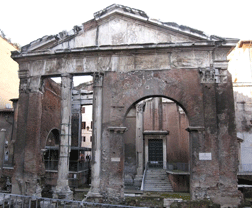 |
| Portico d’Ottavia |
Rome’s ghetto was founded in 1554 by Pope Paul IV, forty years after the first ghetto in Venice because, after 1492, when Spain expelled all the Jews who refused to convert to Christianity, they made their way to Rome as did the Jews in Sicily, which was under Spanish rule at that time. Thus Rome’s Jewish population doubled to about 5,000 people, and so frightened the Pope that he forced them to live together behind three gates locked at night in a malarial and flood-prone six acres on the left bank of the Tiber. Although not without suffering prejudices previously, these merchants, bankers, physicians, craftsmen and papal servants, were now forbidden to work except as rag sellers and money lenders (restrictions which remained in place for over three hundred years). They were also required to attend Mass regularly and urged to convert to Catholicism, although few did. Because of their overcrowded, cramped quarters, friggitori, or fry shops, were set up in the streets for those families who had no kitchens. These gave birth to carciofi alla giudia, fiori di zucca, filetti di baccalà, deep-fried artichokes, zucchini flowers, and salt cod fillets Jewish-style, still the most popular dishes of Italian Jewish cuisine, which like the population has Sephardic, not Ashkenazita (German and North-Eastern European), roots.
The Ghetto was not demolished until 1870 when Italy was unified and King Victor Emanuel II granted the Jews full Italian citizenship (one named Ernesto Nathan was even mayor of Rome
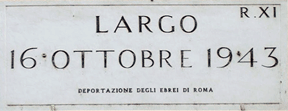 |
|
Plaque commemorating the deportation of Rome’s 2,019 Jews to Nazi death camps
|
from 1907-13) and the right to live anywhere they wished. However, many chose to remain in their close-knit neighborhood with its centuries of tradition which almost certainly led to another dark episode in their local history, today commemorated with several on-site wall plaques. On October 16, 1943, the Nazi German occupiers rounded up Jews throughout Rome, but the ghetto was their collection point. From the Piazza Portico d’Ottavia 2,091 were deported to death camps in Germany and Poland; only 16 returned.
This Portico, restored in 32 AD and named by Augustus in honor of his sister Ottavia, the wife of Mark Antony, was part of a large complex, the Circus Flaminius, where there had been great temples to Jupiter and to Juno. During the Middle Ages the Portico was the city’s fish market and the nearby church Sant’Angelo in Pescheria (meaning fish market) was one of the churches where the Jews of the ghetto were forced to listen to Christian sermons.
 |
|
Street sign of ghetto’s main street |
Jews have lived in Rome for more than 2,000 years, making it the oldest Jewish community in Europe. According to Diane Seed in her must-have book, Love Food, Love Rome, produced by AA Publishing in 2006: “In 161 B.C. the Maccabees sent envoys to Rome, and merchants soon followed to explore business opportunities.” When Rome invaded Judaea a century later, the first members of Rome’s permanent Jewish community arrived in 61 B.C. as Pompey’s enslaved prisoners of war, but with the right to regain their freedom. Another century or so later, after the Emperor Titus destroyed the Temple in Jerusalem in 70 A.D., the community greatly expanded.
Today Rome is home to 13,000 of Italy’s 35,000 Jews and boasts six synagogues, all Orthodox (though only 300 still live in the now prime real estate ghetto according Francis X. Rocca’s article, “Roman Jews fight for Ghetto’s ‘soul'”, published in The Boston Globe, November 26, 2006). The main synagogue, called Il Tempio Maggiore and founded in 1904, is only a very
short walk from Yotvata. In its basement is Rome’s Jewish Museum, (Lungotevere Cenci 15,
 |
|
Rome’s main synagogue
|
tel. 011-39-066840061).
Other Jewish sights are: the Menorah carved on the Arch of Titus in the Roman Forum; and five Jewish catacombs, believed by scholars to predate the Christian ones by at least a century (Villa Torlonia, Vigna Apoloni, Vigna Cimarra, Vigna Randanini, and Monteverde). To reserve a visit to the one in Villa Torlonia, telephone 011-39-340-7368280. For walking tours of Jewish Rome contact Micaela Pavoncello, tel. 011-39-328-8638128 or David Walden, tel. 011-39-339-7059603).
Besides Yotvata, Rome counts two Kascèr Bed-and-Breakfasts (Nice Flat: Via Arenula, and Nice Flat: Via di Portico d’Ottavia, tel. 011-39-066793844), four Kascèr restaurants, fourKascèr pizzerie, one Kascèr bakery “Antico Forno del Ghetto,” famous for its bread called “ossi” meaning bones (Piazza Costaguti 30, tel. 011-39-0668803012), and one tiny hole-in-the-wallKascèr pastry shop “Zi Boccione” (Via Portico d’Ottavia 1, tel. 011-39-066878637). It’s a recently-uncovered favorite of Pope Benedict XVI’s, thanks to a gift from his Jewish physician Dr. Giacomo Perugia of pastry chef Vilma Limentani’s almond and cinnamon biscuits, and a kind of “Jewish strudel” or pastry roll of candied fruits, almonds, raisins and pine nuts. It’s called “pizza ebraica” or “tronchetto” here in Rome, but “sfratto” or “eviction” in other Italian Jewish communities.
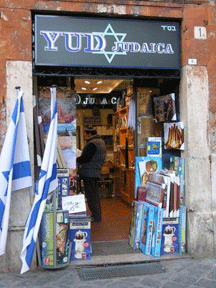 |
|
Souvenir shop in Rome’s ghetto
|
There are another three even better-known “Jewish” but not Kascèr restaurants: Evangelista (Via delle Zoccolette 11a, tel. 011-39-06-6785810), famous for its carciofi al mattone or artichokes squashed between two bricks and baked, a favorite dish of Karol Cardinal Wotiyla before his election as pope; Dal Pompiere (Via Santa Maria dei Calderari, tel. 011-39-066868377), Piperno (Via Monte de’ Cenci 9, tel. 011-39-0668806629), already famous with foreign tourists when the ghetto was still locked at night.
Da Lisa is located near the Coliseum, not in the ghetto, and serves Besarì — more meat-based Kascèr (Via Foscolo 16/18, tel. 011-39-0677200460). Named for its devout Libyan-born owner and chef, Lisa Giuli, who spent several years in Israel, Da Lisa has specialties that include cous cous, humus, and kebabs. In fact, from the menu, you might think that you were in Damascus. Sample thebaraimi (fish with a hot tomato sauce) and the honey-sweetened pastries which Lisa makes herself. Hebrew and English spoken. No credit cards.
Also Libyan-born is the owner of his namesake besarì restaurant Da Alfonso (Via del Galla e Sidama 9b, tel. 011-39-06686200184), which he runs with his son Rami. Since their couscous is considered the best in Rome, it’s advisable to book ahead. Their spicy fish and home-made desserts are also delicious.
Like Da Lisa and Da Alfonso, the specialties at besarì Oriental Food Kosher (Via Livorno 10, tel. 011-39-06-4404840, www.kosherinrome.it) have a “Middle-Eastern” flair: lamb on a spit, couscous, kebabs al mafrum, felafel, humus, and honey-based sweets. But the Israeli owners are inhospitable and have no savoir-faire. They prefer to talk on their cell phones rather than to greet their guests. Its out-of-the way location in a non-descript residential neighborhood is a double drawback.
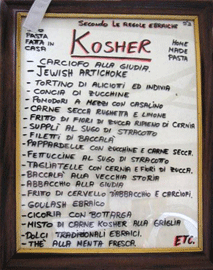 |
|
The menu of La Taverna del Ghetto
|
A favorite of Rabbi-emeritus Elio Toaff, La Taverna del Ghetto (besarì, Via Portico d’Ottavia 8, tel. 011-39-0668809771), in a 14th-century palazzo in the heart of the ghetto, offers delicious pasta dishes (the best is with grouper and zucchini flowers), as well as grilled meats and fish.
Just around the corner Zi’ Fenizia (besarì, Via Santa Maria del Pianto 64, tel. 011-39-066896976), also in the heart of the ghetto, is a pizzeria owned by Michele and Cinzia Sonnino. Besides pizza by the slice with kascèr toppings, they offer supplì (fried Roman rice balls with a heart of mozzarella) and Middle-Eastern felafel.
Pizza e Festa (Via Portico d’Ottavia 1/b, tel. 011-39-066893235) and Besarì Kosher Pizza (Via Luca Magrini 12, tel. 011-39-06-5590790) offer pizza by the slice, as doesDa Michele on Via dell’Umiltà, not far from the Trevi Fountain.
For Kosher products to cook at home, there’s Kosher Delight (via S. Gherardi 16/18, tel. 011-39-065565231), or Kosher Point (Via O.M. Corbino 17, tel. 011-39-065584363), or to cater a party there’s Le Bon Ton Catering (Via Casoria 24/28, tel. 011-39-067026889). Of course, all are closed on Friday evenings and Saturday.
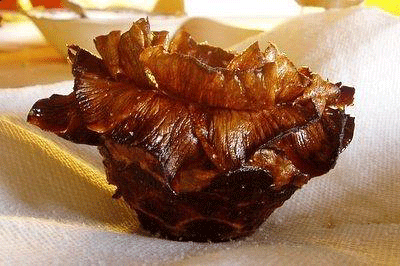 |
|
The deep-fried artichoke is the most famous dish of Roman Jewish cuisine.
|
For handmade-in-Italy silver, ceramic, and Murano glass, Judaica souvenirs including jewelry,chanukiots, and menorahs, stop by Saray (Via del Portico di’Ottavia 14-15, tel. 011-39-066861763, www.saraystore.it).
Annie Sacerdoti’s excellent Guida all’Italia ebraica (Marsilio, 2003) is sadly only available in Italian. Jews and Synagogues (Storti, 1973) gives a good historical picture of the Venice, Rome, Florence, Leghorn communities. Books on Italian Jewish cooking include: Edda Servi Machlin,The Classic Cuisine of the Italian Jews, Everest House, 1881, and Joyce Goldstein, CucinaEbraica: Flavors of the Italian Jewish Kitchen, Chronicle Books, 1998.
